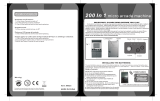iii
• Do not apply pressure or throw objects at your Display. This
may compromise the integrity of the display. The manufacturer’s
warranty does not cover user abuse or improper installations.
• The power cord must be replaced when using dierent voltage
than the voltage specied. For more information, contact your
dealer.
• When connected to a power outlet, power is always owing into
your Display. To totally disconnect power, unplug the power cord.
• The lightning ash with arrowhead symbol within an equilateral
triangle is intended to alert the user to the presence of
un-isolated, dangerous voltage within the inside of your Display
that may be of sucient magnitude to constitute a risk of electric
shock to persons.
• Do not overload power strips and extension cords. Overloading
can result in re or electric shock.
• The wall socket should be installed near your Display and easily
accessible.
• Only power of the marked voltage can be used for your Display.
Any other voltage than the specied voltage may cause re or
electric shock.
• Do not touch the power cord during lightning. To avoid electric
shock, avoid handling the power cord during electrical storms.
• Unplug your Display during a lightning storm or when it will not
be used for long period of time. This will protect your Display
from damage due to power surges.
• Do not attempt to repair or service your Display yourself.
Opening or removing the back cover may expose you to high
voltages, electric shock, and other hazards. If repair is required,
contact your dealer and refer all servicing to qualied service
personnel.
• WARNING: Keep your Display away from moisture. Do not expose
your Display to rain or moisture. If water penetrates into your
Display, unplug the power cord and contact your dealer. Continuous
use in this case may result in re or electric shock.
• Do not use your Display if any abnormality occurs. If any smoke
or odor becomes apparent, unplug the power cord and contact
your dealer immediately. Do not try to repair your Display
yourself.
• Avoid using dropped or damaged appliances. If your Display is
dropped and the housing is damaged, the internal components
may function abnormally. Unplug the power cord immediately
and contact your dealer for repair. Continued use of your Display
may cause re or electric shock.
• Do not install your Display in an area with heavy dust or high
humidity. Operating your Display in environments with heavy
dust or high humidity may cause re or electric shock.
• Follow instructions for moving your Display. Ensure that the
power cord and any other cables are unplugged before moving
your Display.
• When unplugging your Display, hold the AC/DC power adapter,
not the cord. Pulling on the power cord may damage the wires
inside the cord and cause re or electric shock. When your
Display will not be used for an extended period of time, unplug
the power cord.
• To reduce risk of electric shock, do not touch the connector with
wet hands.
• Insert batteries in accordance with instructions. Incorrect
polarities may cause the batteries to leak which can damage the
remote control or injure the operator. Do not expose batteries to
excessive heat such as sunshine, re or the like.
• If any of the following occurs, contact the dealer:
- The power cord fails or frays.
- Liquid sprays or any object drops into your Display.
- Your Display is exposed to rain or other moisture.
- Your Display is dropped or damaged in any way.
- The performance of your Display changes substantially.
• This apparatus shall not be exposed to dripping or splashing and
no objects lled with liquids, such as vases, shall be placed on the
apparatus.
• The mains plug or appliance coupler is used as the disconnect
device, the disconnect device shall remain readily operable.
• CAUTION - These servicing instructions are for use by qualied
service personnel only. To reduce the risk of electric shock, do not
perform any servicing other than that contained in the operating
instructions unless you are qualied to do so.
• The lightning ash with arrowhead symbol within an equilateral
triangle is intended to alert the user to the presence of
uninsulated DANGEROUS VOLTAGE within the product’s
enclosure that may be of sucient magnitude to constitute a risk
of electrical shock to persons.
• WARNING: Exposure to loud sounds can damage your hearing
causing hearing loss and tinnitus (ringing or buzzing in the ears).
with continued exposure to loud noises, ears may become
accustomed to the sound level, which may result in permanent
damage to hearing without any noticeable discomfort.
• Install the Display where it cannot be pulled, pushed or knocked
over.
• Do not allow children to hang onto the product.
• Store the accessories (remote, batteries, etc.) in a location safely
out of the reach of children.
• The American Academy of Pediatrics discourages television
viewing for children younger than two years of age.
• WARNING: Never place a television set in an
unstable location. A television set may fall, causing
serious personal injury or death.
• Many injuries, particularly to children, can be
avoided by taking simple precautions such as:
• Using cabinets or stands recommended by the manufacturer
of the television set.
• Only using furniture that can safely support the television set
• Ensuring the television set is not overhanging the edge of the
supporting furniture.
• Not placing the television set on tall furniture (for example,
cupboards or bookcases) without anchoring both the furniture
and the television set to a suitable support.
• Not placing the television set on cloth or other materials that
may be located between the television set and the supporting
furniture.
• Educating children about the dangers of climbing on furniture
to reach the television set or its controls.
• If your existing television set is being retained and relocated, the
same considerations as above should be applied.





















